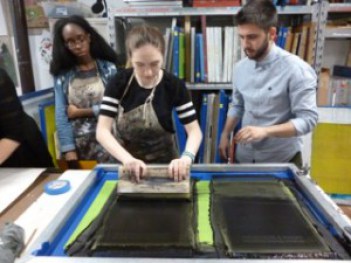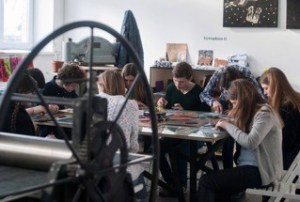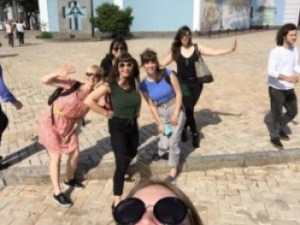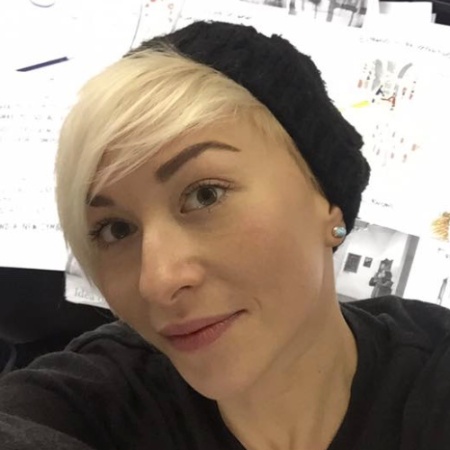

I’ve always felt that contemporary museums should help transform education, involve communities, and contribute to social inclusion, but wasn’t sure how this could be achieved in Ukraine. During the Museums Connect program, I met U.S. activists who are designing and implementing relevant community-based arts and educational initiatives that incorporate social work practices to engage different ages and community groups. As a result, I’ve learned how cultural activists in Ukraine can create pathways for communities to lead engagement efforts by Ukrainian museums and arts organizations. This experience has strengthened my conviction – arts-based educational programs and community-focused initiatives can be effective strategies for catalyzing social change and democratic transformation in Ukraine.
I would like to share some of my thoughts on why this project worked, and what best practices emerged from this collaboration. Brighter Worlds: Confronting Violence Through Youth-oriented Media was a joint project implemented through a partnership between a Ukrainian arts foundation IZOLYATSIA and AS22O, a nonprofit center for the arts in Providence, RI. The project was administered by the American Alliance of Museums through the Museums Connect program. In developing the program concept, AS22O and IZOLYATSIA sought to connect Ukrainian youth affected by the Russian military intervention in Eastern Ukraine and Crimea, with underserved Rhode Island youth to explore how the use of art and technology can help to channel their experiences in a positive and empowering way.

While this was an ‘international museum partnership’, the U.S. and UA programs focused on addressing local issues relevant to communities in Kyiv and Providence. As a result, the programs in the two cities were different. In Providence, the program explored sociopolitical themes found in science fiction medias and current events to inspire projects to address an ‘issue’ that was of great importance to the American students and U.S. society at large. In Kyiv, the program focused on involving Ukrainian youth who have experienced hardship in their lives into an active role in their communities and providing young people with practical skills to help them succeed in Ukraine’s developing creative industries field. In both countries, young, college-aged instructors educated even younger youth in traditional and new media techniques like 3D modeling, laser cutting, and small scale model building to complete the final projects. Both programs took place in immersive, community-based arts spaces to give young participants access to art and technology and connect them with close-in-age mentors who sparked their creativity and supported them in their explorations. The program resulted in a website, a strong social media presence, a youth-developed curriculum, as well as exhibitions in both cities that were created and installed by the participants.
Why did this collaboration work? I think it was successful because the individuals that were initially involved in developing the program concept at both organizations in different countries shared common values – engaging underserved communities and disadvantaged youth through art, community development, and social transformation. Additionally, these same individuals were responsible for achieving the project’s goals. In effect, the project was aligned with the mission of the two institutions, and the staff had a direct personal stake- they sought to realize their values and principles through this collaboration. As a result, cultural activists working on similar issues in different countries had a chance to connect, deepen their relationship, and exchange ideas on educational programming, social work practices, community arts, and creative placemaking.
From my Ukrainian perspective, several best practices have emerged from this project. First, collaborative platforms offered by museums and arts organizations to the community are more effective when they incorporate educational programs that focus on involving the local community. In this project, the educational programming in both countries took place in action-oriented, inclusive creative media workshops, but also gave youth access to professional technology and art, and connected them to artists, activists, and mentors who guided them in this process. Second, a mentee-protégé relationship between students and instructors (3-7 year age difference) is crucial to stimulate curiosity, learning, and trust. To illustrate, the youth worked together with near-peer instructors to design, produce and install their projects for the final exhibition. Students acquired new practical skills from their instructors, who have become their friends and mentors, and both groups have become empowered through this experience. Third, the curriculum should be co-developed by the youth. Ukrainian young people are eager to obtain knowledge and practical experience that is not offered by Ukraine’s formal educational system. For example, the curriculum developed by Ukrainian youth blended practice and theory. Specifically, students learned printmaking techniques (silk screen printing, lithography, linocut, etching, woodcut, monotype, etc.), analog photography, and how to operate a laser engraver, milling machine, and a 3D printer in a digital fabrication laboratory. At the same time, instructors guided students in exploring topics that are not adequately covered in most Ukrainian schools and colleges, such as developing authentic ideas and fundraising skills, copyright issues, contemporary art and curating, social media art, urbanism, politics, and activism.
Another important takeaway from this project for Ukraine is that community-focused educational programs as strategies for positive social change work best in the long run if they are sustainable and relevant to the communities. It appears that programmatic continuity for similar youth-led initiatives in Ukraine can be ensured by partnering with Ukrainian community service programs (similar to AmeriCorps in the U.S.) capable of mobilizing volunteers interested in serving as youth mentors[1]
Throughout this project, the Ukrainian team at IZOLYATSIA has been inspired by AS22O’s dedication to strengthening the creative potential of the Providence community. In turn, our U.S. partners have been inspired by Ukraine’s volunteer movement, and the resilience of regular citizens throughout the Revolution of Dignity, and the continuing war in eastern Ukraine. For both countries, such local projects help bring up engaged youth and critical thinkers who have the skills to be artists, innovators, educators, and leaders that uphold the values of artistic expression, dignity, freedom, justice, tolerance, and community. The result of the U.S. elections and its impact on American society, and Ukrainian society’s continued struggle for democracy against corruption, further validate why the work of museums/arts organizations and the community is so important right now. I draw inspiration for our continued efforts from the words of cultural anthropologist Margaret Mead – “Never doubt that a small group of thoughtful, committed citizens can change the world. Indeed, it is the only thing that ever has” [2].

Ksenya Kyrychenko is a cultural activist and independent museum professional. She advises Ukrainian museums and civil society organizations on governance, management, strategy, community engagement, and educational programming. In 2015-2016 Ksenya was the coordinator of AAM’s Museums Connect project in Ukraine – an innovative arts-based educational project for Ukrainian and American youth, initiated by the U.S. Department of State’s Bureau of Educational and Cultural Affairs, and administered by the American Alliance of Museums. Right now Ksenya works with the Revolution of Dignity Museum in Kyiv, where she leads resource mobilization and partnership development efforts. She is interested in exploring new ways in which educators, social activists, artists and community organizers can work to propose critical interventions to stimulate discussion and catalyze social change through the arts in Ukraine. Before pursuing her vocation in the field of museum practice, education and community development, Ksenya was a practicing lawyer in Ukraine, a certified anti-money laundering specialist (2013-2016), and a licensed attorney admitted to the Bar of the State of New York (2008). Ksenya sees her professional path leading to the establishment of a nationwide initiative focused on culture, education, and arts-centered community development intended to strengthen the social and economic fabric of Ukrainian communities.
[1] For example, this model works well for City Year, Inc. a U.S. education-directed nonprofit that deploys (through AmeriCorps) teams of young people to serve as “near-peers” in high-poverty schools nationwide.
[2] NAEA Anthology: Art Education for Social Justice, Editors: Tom Anderson, David Gussak, Kara Kelley Hallmark, and Allison Paul, NAEA, 2010.








